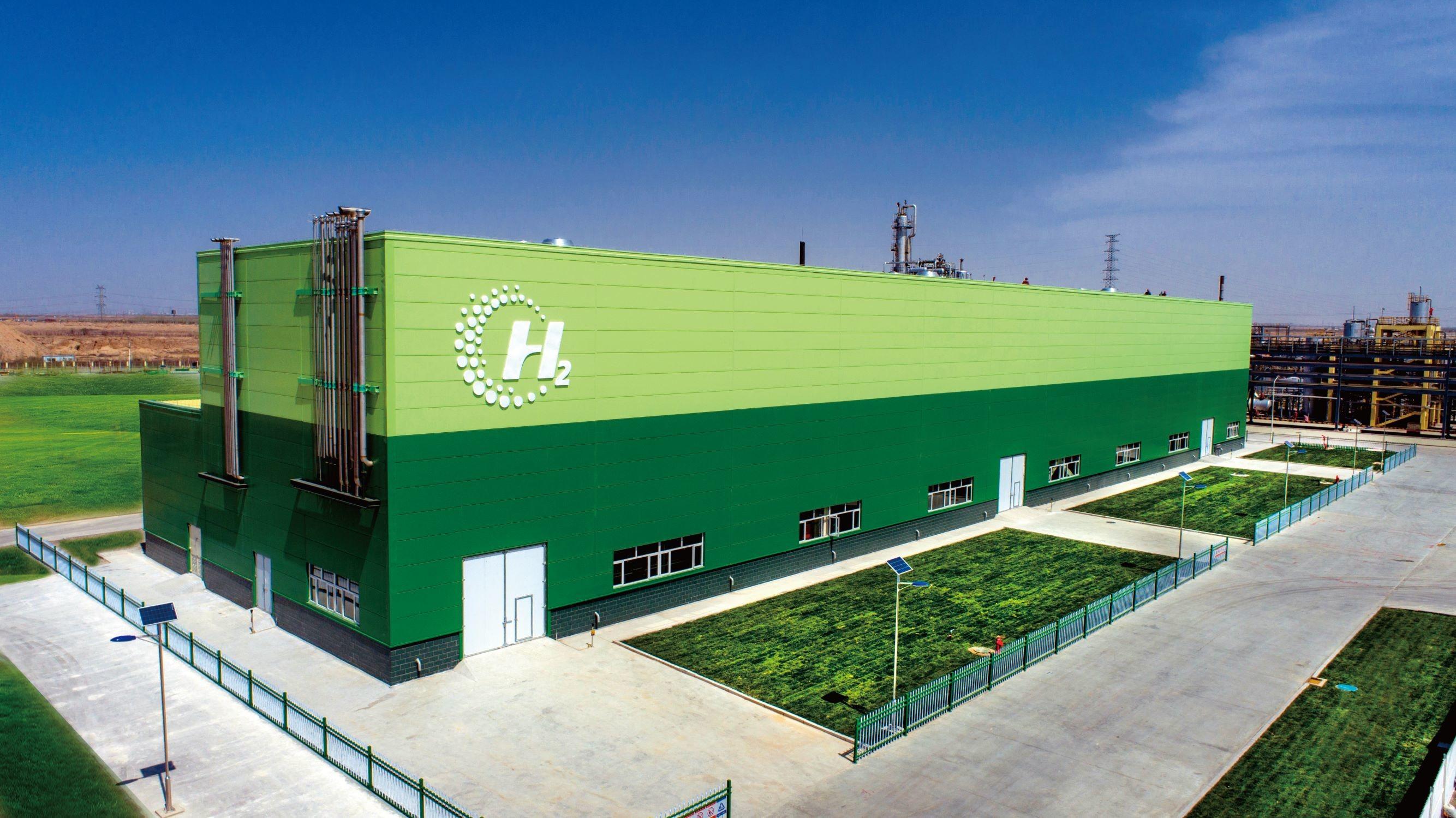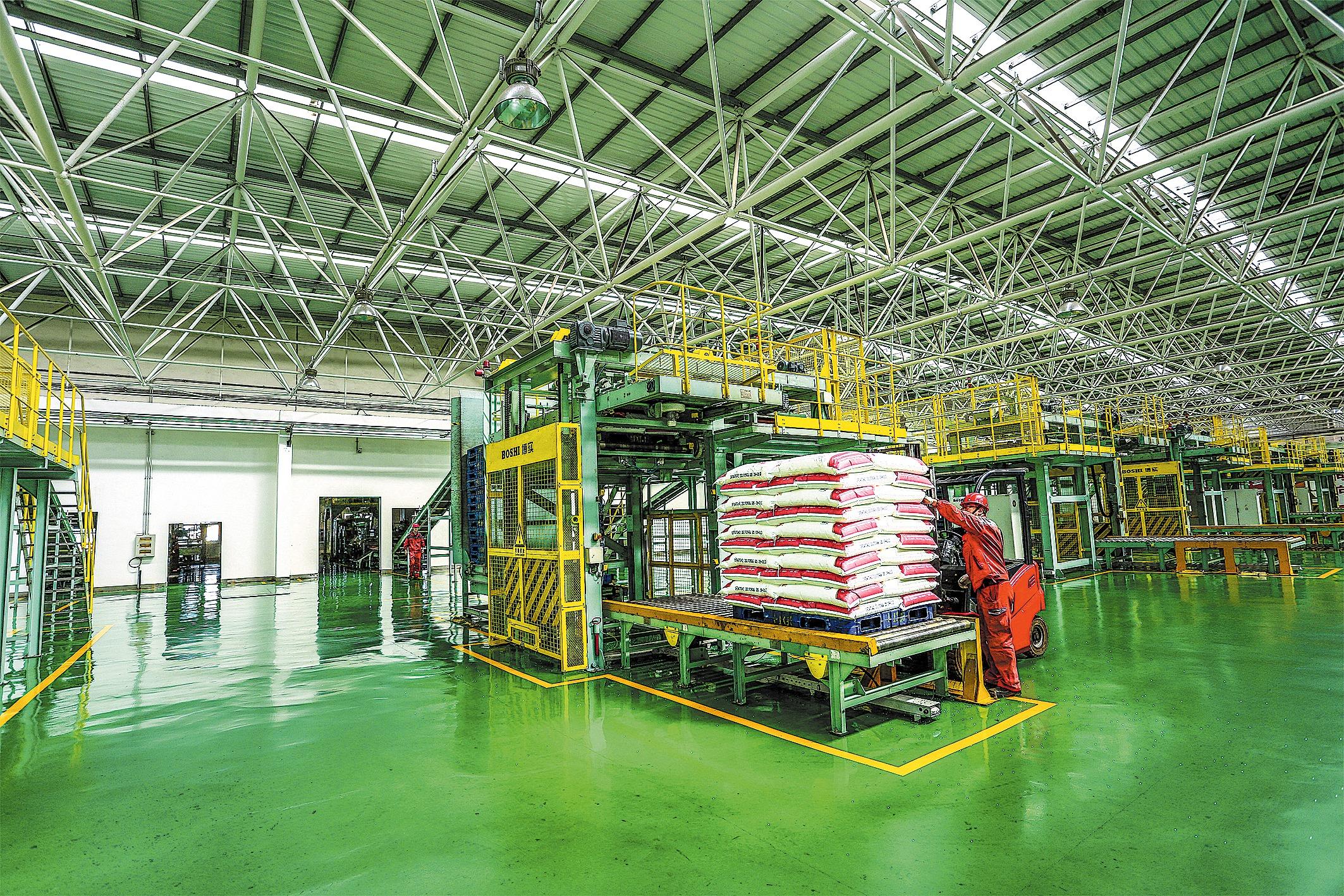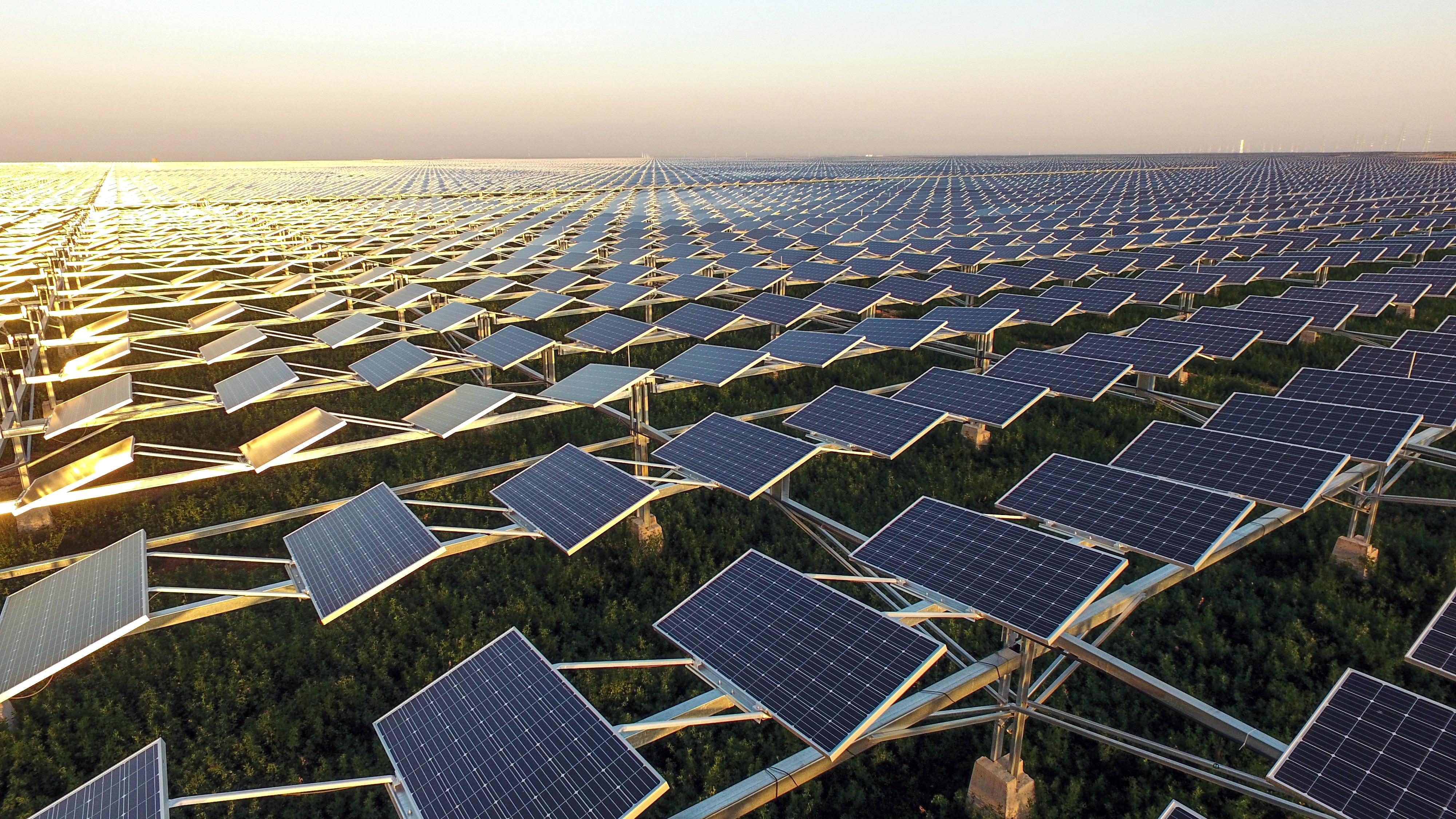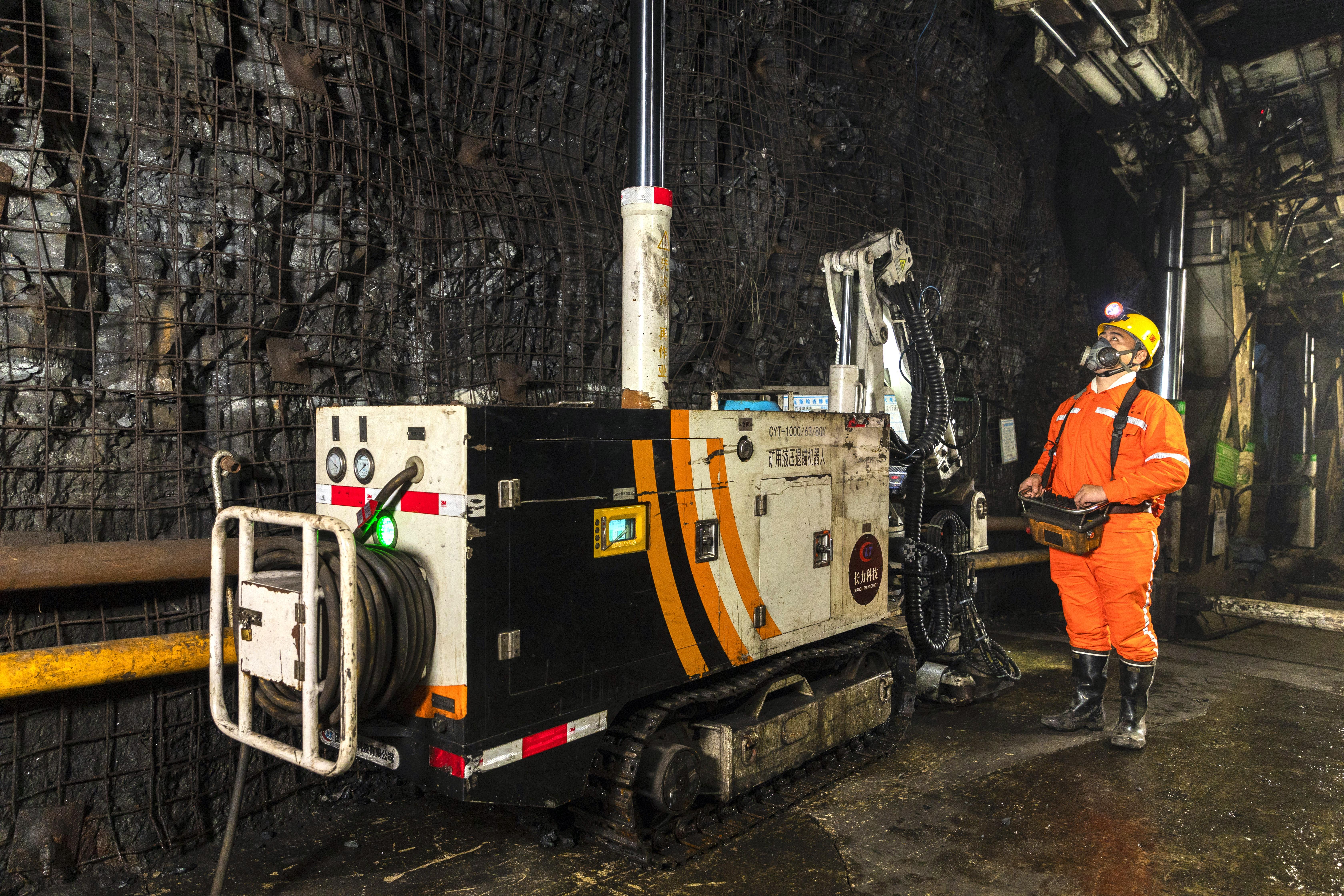Base reduces pollution caused by traditional working practices. Hou Liqiang reports from Beijing, with Hu Dongmei in Yinchuan and Yuan Hui in Hohhot.
 A solar-powered green hydrogen plant located at the Ningdong Energy Chemical Industry Base in the Ningxia Hui autonomous region. The plant's annual hydrogen output is 600 million cubic meters and it can reduce carbon emissions by 1.4 million metric tons every year. (PHOTO PROVIDED TO CHINA DAILY)
A solar-powered green hydrogen plant located at the Ningdong Energy Chemical Industry Base in the Ningxia Hui autonomous region. The plant's annual hydrogen output is 600 million cubic meters and it can reduce carbon emissions by 1.4 million metric tons every year. (PHOTO PROVIDED TO CHINA DAILY)
Editor's note: As protection of the planet's flora, fauna and resources becomes increasingly important, China Daily is publishing a series of stories to illustrate the country's commitment to safeguarding the natural world.
Across a vast expanse of desertified land, continuous rows of photovoltaic power panels shine in the sunlight and stretch as far as the eye can see.
It may look no different from the other solar energy stations China has built in desert areas, but the project is part of the Ningdong Energy Chemical Industry Base in the Ningxia Hui autonomous region.
The base consumes 55 million metric tons of coal and emits more than 67 million tons of carbon dioxide every year.
This vast facility for solar energy development, with an installed capacity of 500,000 kilowatts, is a microcosm of the great endeavors made by the base and the government to transform China's coal-to-chemical industry.
Having been put into operation and connected to the national grid in late June, the facility is just one part of a demonstration project for hydrogen production and the reduction of carbon emissions at the base, one of the country's largest coal-to-chemical industry hubs.
When completed on schedule at the end of the year, the demonstration project, developed by the CHN Energy Investment Group, will also see two hydrogen production plants put into use, each with the capacity to make 20,000 standard cubic meters of hydrogen an hour.
Moreover, the project will include two hydrogen refueling stations, hydrogen pipelines and a batch of heavy-duty trucks powered by the gas.
"We are developing new advantages. That is, using clean energy to replace fossil energy, and especially to replace coal with hydrogen made from renewable energy to reduce energy consumption and carbon emissions in the industry," said Tao Shaohua, head of the management committee at the base.
In addition to shifting from coal to hydrogen in production, the base will make efforts to develop hydrogen-powered transportation and manufacture hydrogen-related equipment for the storage and transportation of liquid hydrogen, he added.
 An employee of the Ningxia Baofeng Energy Group checks products made at the hydrogen plant. (PHOTO PROVIDED TO CHINA DAILY)
An employee of the Ningxia Baofeng Energy Group checks products made at the hydrogen plant. (PHOTO PROVIDED TO CHINA DAILY)
More programs launched
The demonstration project is just one of a number of similar hydrogen programs that have been launched at the base, the management committee said. For example, in April 2021, the Ningxia Baofeng Energy Group put into operation a hydrogen plant that is supported by a 200-megawatt solar power station. The plant uses electrolysis to make hydrogen from water.
"Currently, Baofeng's annual green hydrogen output has reached 600 million cu m. Every year, the hydrogen can replace 800,000 tons of feed coal and reduce carbon emissions by 1.4 million tons," said Liu Yuanguan, Baofeng Energy's president, in an interview with Economic Information Daily earlier this year.
According to the Ningdong management committee, the base produced 22,100 tons of green hydrogen last year.
The base plans to raise the capacity to 80,000 tons by 2025, cutting the use of standard coal by 900,000 tons and reducing carbon dioxide emissions by 2 million tons.
Its production of green hydrogen is set to shoot up to 300,000 tons as of 2030, reducing consumption of standard coal by 3.6 million tons. By the same year, 9 million tons of carbon dioxide emissions will either be reduced or used in processes at the base.
Practices at the Ningdong base show that for every ton of green hydrogen that replaces hydrogen made from coal, an average of 10 to 11 tons of standard coal will be saved and 25 tons of carbon dioxide emissions will be prevented, according to the base.
Despite that, Zhao Rui, deputy general manager of Ningdong New Energy Industry Development, a company affiliated with the management committee at the base, said, "Many of the hydrogen projects at the base are still small-scale ones for demonstration purposes."
Currently, the cost of green hydrogen made from renewable energy is at least twice that of hydrogen made from coal, he said.
With the exception of maintenance work, facilities for chemical production in Ningdong should work nonstop, he added, noting that the suspension of work not only brings financial losses for the operators, but also results in a higher level of safety risks.
However, the intermittent nature of solar and wind energy poses great challenges for the application of green hydrogen in the chemical sector, and while power storage provides a solution to the problem, its cost remains high for the Ningdong base, he said.
Pumped storage is currently the most cost-effective way of storing power, but conditions don't allow for the construction of such facilities at Ningdong, he added.
 Solar panels are erected to supply power to the plant, which is owned and operated by Baofeng Energy. (PHOTO PROVIDED TO CHINA DAILY)
Solar panels are erected to supply power to the plant, which is owned and operated by Baofeng Energy. (PHOTO PROVIDED TO CHINA DAILY)
As a traditional method of storing power, pumped storage sends water to higher locations using surplus power during off-peak consumption periods, then regenerates it to meet emerging power requirements.
Zhao also noted a great opportunity for the development of green hydrogen.
The price of polycrystalline silicon, a major material in the production of solar panels, surged last year. However, this year the price has fallen sharply. "I expect that the hydrogen industry will embrace a good development period," he said.
In another move to decarbonize its coal-to-chemical operations, the base commenced the construction of a carbon capture, utilization and storage project, or CCUS, in May.
"Once it goes into operation, the project will have the ability to reduce carbon dioxide emissions by 3 million tons a year, which is equivalent to planting 27 million trees," said Wang Xiaohan, an official with the management committee at the base.
That reduction roughly equals the amount of carbon dioxide emissions that would be prevented by banning the use of all civilian cars in Ningxia for two years, he added.
The CCUS project will capture carbon dioxide emissions from a coal liquefaction plant in Ningdong. The greenhouse gases will then be transported to the Changqing oilfield in Ningxia, and after they have been used to recover the oil, the gases will be stored underground. The project will be constructed in three phases, with a total planned investment of more than 100 billion yuan ($137 million), according to the management committee.
The first phase of the project will go into operation next year, with the second phase opening in 2025. The base will start building the third phase during the period of the 15th Five-Year Plan (2026-30).
After the project becomes fully operational, 74.5 million tons of carbon dioxide is expected to be injected underground for storage during the operating period of 30 years, which may help raise oil output by more than 17 million tons.
"It will not only become the country's largest full-chain CCUS project, but also provide low-carbon development experiences that will be applicable to coal-to-chemical industries across the country," said Ma Cheng, a senior official with the Ningdong management committee.
 A miner operates a machine to extract coal from a mine in Ordos, Inner Mongolia autonomous region. (PHOTO PROVIDED TO CHINA DAILY)
A miner operates a machine to extract coal from a mine in Ordos, Inner Mongolia autonomous region. (PHOTO PROVIDED TO CHINA DAILY)
Wider application
In Ordos, Inner Mongolia autonomous region, efforts have been strengthened to tap the potential of green hydrogen and help transform the city's huge coal-to-chemical industry.
For example, in February, China Petroleum & Chemical Corp, aka Sinopec, launched its first hydrogen demonstration project in the city.
Once operational, the project will make full use of the rich solar and wind energy resources in Ordos. It is expected to produce 30,000 tons of green hydrogen and 240,000 tons of green oxygen a year, Sinopec said.
The hydrogen and oxygen will be transported via pipelines to a compound for the deep processing of coal, replacing hydrogen produced by coal.
As the world's largest such project under construction, it is expected to reduce carbon dioxide emissions by more than 1.4 million tons every year.
"The project is of great significance for guaranteeing China's energy security, building new energy systems and advancing green energy and low-carbon development in Inner Mongolia," said Ma Yongsheng, Sinopec's chairman, in a media release from the company.
At the national level, great importance has been attached to the green transformation of the coal-to-chemical sector. According to a notification document released by the National Development and Reform Commission in June, China will strictly control the approval and size of new coal-to-chemical projects.
The document — issued by six national government departments, including the Ministry of Industry and Information Technology — said the country will boost the coupling of the modern coal-to-chemical industry with the development of renewable energy, green hydrogen and a number of yet-to-be-built CCUS projects.
The document was not intended to restrict the development of the coal-to-chemical industry, but to accelerate the growth of the sector in a healthier, higher-quality and sustainable manner, according to Wang Xiujiang, deputy secretary-general of the committee of the coal chemical industry at the China Petroleum and Chemical Industry Association.
Xinhua contributed to this story.
Contact the writers at houliqiang@chinadaily.com.cn


